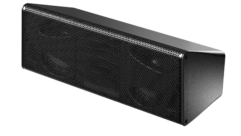Testing a constant voltage loudspeaker system
Jul 20, 1996 12:00 PM,
Glen Ballou
Many tests — and inexpensive test instruments — can assure proper operation of a constant voltage system.
Constant voltage systems are designed to connect amplifiers to loudspeakers that are a long distance from the amplifier or to connect many loudspeakers to the amplifier. This obviously includes a lot of sound systems, so it behooves the sound-system installer or repair person to know how to properly test such a system. To better understand why this clever way of wiring a sound system came into being, let’s look at some of the problems you would have if you didn’t use a constant voltage system in your installation.
Loudspeakers are connected to amplifiers, directly or through transformers. Home stereo loudspeakers and large complex loudspeaker arrays, such as those used during live performances, are most often connected directly to the amplifier. This produces the cleanest sound, and because the maximum design power from the amplifier is usually at 4 V or 8 V, the direct connection between the amplifier and the loudspeaker produces maximum power from the amplifier.
However, direct wiring does have some disadvantages:* If the common side of the loudspeaker wire shorts to ground, direct wiring could create a ground loop and produce hum.* If the high side of the loudspeaker line shorts to ground, direct wiring would short out the amplifier.* Usually only one or two loudspeakers can be connected to the amplifier without lowering the load impedance below amplifier specification.* Large wire — AWG#12 or larger — is required.* Direct wiring cannot be used effectively where loudspeakers are located a long distance from the amplifier.
In distributed systems, many loudspeakers are connected to the output of the amplifier. If each loudspeaker were connected directly across the amplifier, the load impedance seen by the amplifier, if each loudspeaker is the same impedance, would be the individual loudspeaker impedance divided by the number of loudspeakers across the load line. If eight 8 V loudspeakers were connected to the amplifier, the load the amplifier would see would be 1 V, a load guaranteed to destroy the amplifier. If the loudspeakers connected to the line had different impedance values, the total load impedance would be:
In many systems, the loudspeaker wire run is long, so the power wasted in the wire could be high. For instance, AWG#16 wire has 4 V resistance per 1,000 feet. If the round-trip loudspeaker run is 500 feet (the loudspeakers are 250 feet from the amplifier), the impedance of the wire would be 2 V. Because the total impedance of the eight loudspeakers is 1 V, the loudspeakers would receive only a third of the amplifier power; the other two-thirds of the amplifier power would be dissipated in the wire.
In comes constant voltage systems to the rescue! The constant voltage system was developed to permit easy calculation and installation of distributed sound systems. Common constant voltage systems are 25 V, 70.7 V, 100 V and 200 V.
To have even coverage throughout the listening area, the loudspeaker’s coverage pattern and the ceiling height must be known and the loudspeakers must be laid out with overlap. (See Figure 1.) When too few loudspeakers are used, the sound-pressure level (SPL) will vary between the loudspeakers and will be noticeable in the tests discussed later. If the sound-system designer knows the desired SPL and the sensitivity of the loudspeaker (SPL @
1 W), he may calculate the wattage required at each loudspeaker for a given SPL. The transformer’s turns ratio converts the high impedance of the amplifier’s output to the lower impedance of the loudspeaker, providing efficient power transfer from the amplifier to the loudspeaker. (See Figure 2.) If the turns ratio of the transformer is changed, the power delivered to the loudspeaker can be varied. This allows different loudspeaker and transformer combinations to take different levels of power from the amplifier in a low loss manner. The total power taken from the amplifier is the sum of the wattage for each of the loudspeaker and transformer assemblies.
What is a constant voltage power amplifier as defined for constant voltage loudspeaker systems? Does it mean that the output voltage is always a constant voltage? Definitely not! A constant voltage power amplifier develops rated output power when the rated output voltage is reached and the rated load is connected to it.
To better understand what a real constant voltage amplifier is, you must be aware of the three types of amplifiers: constant voltage, constant current and constant power.
In the constant voltage amplifier, the ratio of the input voltage to the output voltage is always the same; if the input voltage doubles, the output voltage doubles. To accomplish this, the voltage used in the negative feedback circuit in the amplifier is taken from across the load. If the load voltage is less than it should be, the amplifier gain will increase to try to keep the ratio between the input and the output constant. What happens if the load is a short circuit? The output voltage, and hence the feedback voltage, is zero, so the amplifier tries to put out more voltage. To do this it must put out more current. More current means creating more heat and ultimately amplifier failure, hence the reason for protection circuits in constant voltage amplifiers.
In a constant current amplifier, the ratio of the output current to the input current is always the same; the voltage changes with load. Constant current amplifiers are often used with wireless induction loops for hearing assistance systems and simultaneous interpretation systems. (See S&VC, April 20, 1995.) With these amplifiers, the negative feedback voltage is taken across a resistor in series with the load. As the output current increases with the input current, the gain of the amplifier is reduced by the feedback, so the current ratio remains constant.
In a constant power amplifier, the ratio of output power to input power remains constant. To accomplish this, the feedback is taken across the load and in series with the load. Constant power amplifiers are seldom used in audio systems.
Any amplifier can be considered a constant voltage power amplifier but not necessarily a specific one, such as a 70.0 V or 25 V constant voltage power amplifier. For instance, an amplifier delivering 100 W into a 4 V load could be called a 20 V constant voltage power amplifier and the DC rail-to-rail voltage would be 56.6 V. For a direct output 4 V amplifier to be a 70.7 V constant voltage power amplifier, it would have to be capable of delivering 1,250 W to the load. To do this, the DC rail-to-rail voltage would have to be 200 V. The rail voltage must be at least the peak-to-peak voltage of the signal, and can be determined with the following equation:
A more common method of connecting the load to the amplifier is through a built-in or externally mounted output transformer. With this method, the output voltage from the transformer would be 70.7 V and the DC rail-to-rail voltage would be whatever the amplifier designer specifies because the transformer matches the impedance of the load to the output of the amplifier electronics.
The constant voltage system has many advantages:* The amplifier output is usually transformer-coupled, so there is isolation between the loudspeaker line and the amplifier electronics.* Many loudspeakers can be safely connected to an amplifier.* Each loudspeaker usually includes its own matching transformer, which isolates it from the line.* The power delivered to each loudspeaker can be individually adjusted.* A shorted transformer secondary will not render the system useless.* Smaller wire can be used between the amplifier and the transformers because the load impedance is high.* Loudspeaker-transformer units can be hung across the constant voltage line anywhere between the amplifier and the last loudspeaker.
The most common constant voltage system in the United States for distributed systems is 70.7 V. However, 25 V systems are being used more often than in the past. 100 V and 200 V systems are used extensively internationally. The 70.7 V system was first used because wire carrying voltage under 75 V could be run without putting it in conduit, and 70.7 V was used to make calculations simple.
When constant voltage systems came out, computers and hand calculators were unheard of, and all calculations were accomplished longhand or with slide rules. The power to any load is:
In the early days of the 70.7 V system, 500 V rather than 600 V was a standard. To make math simple, 70.7 V was used because 70.72 is 5,000, and 5,000/500 is 10 W. A 1,000 V load would develop 5 W; a 250 V load would develop 20 W.
As electrical codes changed, so did the voltage that could be left out of conduit. In came the 25 V system. This system also became popular in intercoms. Today the electrical codes are much more stringent. Installers should always check local codes before installing any wire, including microphone cable, without conduit.
Of course, constant voltage systems have drawbacks:* Frequency response through transformers is limited, particularly low quality ones.* Transformers usually absorb excessive power at the extreme low end of their response.* Two extra connections must be made during installation.* The transformer requires mounting.* The transformer could be connected backward, loading the amplifier excessively.* The polarity could be reversed.* All transformers have insertion loss, ranging from 0.5 dB in a good transformer to 3 dB in a poor transformer.
Transformer insertion loss can be specified two ways: The power can be specified as the power the transformer takes from the amplifier or as the power the transformer delivers to the loudspeaker. In the first transformer, the power to the transformer is the power given on the transformer specification sheet. The power delivered to the loudspeaker, however, is that power minus the insertion loss in the transformer. Therefore, the power taken from the amplifier by all of the loudspeaker-transformer combinations will be the sum of the individual powers. Although this setup will not overload the amplifier, the SPL out of each loudspeaker will be less than expected. The equation for determining the power delivered to the loudspeaker is:
If we have a transformer with a 1.5 dB insertion loss and the power to the transformer as stated in the spec sheet is 10 W, then the power delivered to the loudspeaker would be
If you had designed the system for 10 W to the loudspeaker and you actually have only 7.08 W to the loudspeaker, the loudspeaker SPL will be 1.5 dB less than expected. If the loudspeaker has a sensitivity of 90 dB (1 W, 4 feet), then the SPL at 10 W would be 100 dB and at 7.08 W would be 98.5 dB.
In a transformer whose loss is rated the second way, the power delivered to the loudspeaker is 10 W , so the SPL will be the designed SPL. Using the same example, the delivered SPL will be 100 dB at 10 W. The input to the transformer and consequently the power drawn from the amplifier will be different, however. This can be found with the following equation:
The power taken from the amplifier would be
If 10 loudspeakers are connected to a 100 W amplifier, they will try to take 141.3 W from it — not a good idea if reliability is required.
Testing the constant voltage systemAs you can see, with the possible problems of improper wiring, short circuits, loudspeakers out of polarity, transformer insertion loss and more, it is important to check out loudspeaker lines before you connect loudspeakers to the amplifier and turning up the gain to a point where something fails.
Many tests can assure the installer that the system is operating properly, and many inexpensive test instruments perform these tests.
The first test that should be made is to determine that the loudspeaker line is not shorted or a transformer connected backward. Although this can be done with a multimeter, impedance meters would be much better. To use a multimeter, place it in ohms and measure from each line to ground and then across the two lines. (See Figure 3.) If the measured resistance is less than 2 V or 3 V, the line would be suspect. To determine where the line is shorted, measure both ends of the line (the first loudspeaker to the last loudspeaker on the line) and then work your way to the problem.
Another method would be to set the multimeter to AC volts, put a sine wave or noise on the line and measure the AC voltage at the output of the amplifier with the load connected and disconnected. Be sure to use only enough signal to measure the line because the amplifier can easily be damaged if too much signal is used. If the voltage changes excessively, the line is defective and needs to be checked further. To do this, check the voltage at various points along the line until the voltage remains constant. The short will be before that point.
A much better method to check out a constant voltage loudspeaker line is with an impedance meter. In the not too distant past, this was accomplished with a 10 pound impedance bridge. This instrument was heavy, clumsy and, with all of its knobs and adjustments, time consuming. Today, small battery-operated portable impedance meters are available.
The standard of the industry for many years was the Sennheiser ZP2 and ZP3. (I am told these units are no longer available.) These units measure true AC impedance at six frequencies between 63 Hz and 16 kHz. By measuring the impedance at various frequencies, you can determine whether the load is reactive or resistive. If the load is short-circuited, the impedance will remain low and approximately the same at all frequencies. If the load is OK, the impedance will vary with frequency, especially with low quality loudspeakers and transformers. If a transformer is connected backward, the impedance will also vary with frequency and the load will have a low impedance.
The Electro-Dynamics 400, which has been on the market since 1978, produces direct readings of impedance and watts when a loudspeaker line is driven to operating level (25 V, 70 V, 100 V and 140 V). This unit has an extremely soft test tone that allows the user to test a system during working hours without employees hearing the tone. It offers a built-in five-frequency oscillator, although an external oscillator can be plugged in. The unit checks individual intercom lines for proper wattage at a rate of one per second, testing transmission from console to voice coil in a single step. Testing with an AC signal allows nonsymmetrical load-ground conditions to be tested.
A relative newcomer to the market is the Gold Line ZM1. This unit not only measures the AC impedance but also measures the calculated power. Because most systems are specified using watts and not impedance, this instrument simplifies testing. The ZM1 rapidly provides an accurate measurement of the individual loudspeaker-transformer AC impedance and calculated power delivered to it by the amplifier when that individual loudspeaker-transformer is measured.
The total load AC impedance and calculated power as seen by the amplifier is measured when the ZM1 is connected to the entire load. The ZM1 provides 100 Hz, 330 Hz, 1 kHz and
10 kHz sine waves, measures up to 20,000 V on the impedance scale and calculates up to 2,000 W on 25 V, 50 V, 70 V and 100 V systems at each frequency. The ZM1 calculates the watts for you.
To use an impedance meter, simply connect it across the circuit in question and measure it at various frequencies. Remember to disconnect the amplifier from the device under test (DUT); it could damage the test equipment, and the extremely low output impedance of the amplifier would make the test inaccurate. (It is not uncommon to have an amplifier output impedance of 0.1 V or less.)
If you have a real time analyzer (RTA) and a pink-noise source, you can build a black box to work in conjunction with your RTA to produce an impedance curve for the frequencies displayed on your RTA. (See Figure 4.)
The theory behind the circuit (Figure 5) is the fact that a constant-current output device, i.e. a power amplifier with a build-out resistor in its output, has its voltage output vary directly as the impedance of the load varies.
The black box operates as follows: With the “calibrate-read” switch in “calibrate,” a voltage divider is made of the 51 kV, 5.1 kV, or 430 V resistor and the equivalent load resistor
(5 kV-4 V). By connecting an RTA to the junction of the voltage divider and common, we see a straight line that can be adjusted on the RTA for the reference impedance.
Switching the “calibrate-read” switch replaces the calibrated resistor with the load. If the load is purely resistive and the same resistance as the standard, the RTA scan will be the same. If the impedance is twice or one-half the standard, the RTA will be ±6 dB from the standard. To calculate the load impedance, use the following equation:
If the load is not a pure resistance, the scan will vary up and down around the standard, depending on the impedance at each frequency.
The first question we must ask ourselves if we see this kind of impedance curve is, “What will the frequency response of that loudspeaker be with a constant voltage amplifier?” After all, if power is directly related to impedance, and the impedance is constantly changing, why isn’t the frequency response also changing?
The loudspeaker frequency response is defined as ±x dB sound-pressure level with a ±x dB voltage response into the loudspeaker or into a flat response amplifier. Loudspeakers are inherently more efficient at high impedance. Therefore, at the upper frequencies of Figure 4, it takes less power to produce the same sound-pressure level as at 250 Hz.
The loudspeaker in Figure 4 has two peaks, at 31.5 Hz and 80 Hz, because of the cabinet port. This causes the loudspeaker system to be more efficient at these frequencies, so the overall frequency response of the loudspeaker system is flat.
If the loudspeaker were fed by a constant current amplifier, the frequency response of the system would look like the frequency response of Figure 4. As you can see, the loudspeaker designer must work magic to produce a flat frequency response loudspeaker with all of the varying parameters.
If you are in the market for a new RTA, the Gold Line DSP-30 series does all of the standard RTA measurements as well as measuring RT60, signal delay and AC impedance directly in the same manner as the black box previously discussed. The one exception is it uses a DSP and is extremely accurate. The DSP-30 can be used with a PC with Windows, making for easy storage on the computer’s hard drive, operating in the Windows environment and printing from the computer.
Once we are confident the line impedance is correct, we can check the output of each loudspeaker to determine whether each transformer is set on the correct tap and that the loudspeakers are all in the same polarity.
The simplest method is to put pink noise (or FM interstation noise if you don’t have pink noise), into the system and walk under each loudspeaker. If one loudspeaker sounds louder or softer than the others, the power taps are probably wrong.
If the coverage pattern is proper, you should only hear a small dip in level as you walk between the loudspeakers, and mostly at the higher frequencies. If you hear a large, erratic dip, one of the loudspeakers is probably out of polarity.
By walking between the group of loudspeakers where the dip occurs, you should be able to determine which one is out-of-polarity and reverse it. Then walk the area again and check whether the problem has been corrected. A better method to check the loudspeakers would be with an RTA and pink noise, observing as before.
Polarity is not always easy to determine in a reverberant space. Fortunately a few manufacturers produce polarity checkers. Two are the AB International Electronics ABM phase checker and the Gold Line APT2 polarity/phase analyzer.
With these units, the transmitter section sends out a pulse to either a small built-in loudspeaker or to an electronic jack. The receiver end is either a built-in microphone or an electronic jack. When the transmitter loudspeaker is placed in front of the sound-system microphone and the receiver microphone is placed in front of the sound-system loudspeaker, the absolute polarity of the entire electroacoustic system is tested.
It is important that the receiver be held close to the loudspeaker — within 6 to 8 feet (1.82 m to 2.4 m) maximum — for accurate results. If the receiver is too far from the loudspeaker, the room can affect the results. When the signal is electronically connected to an electronic device and the receiver is electronically connected to the output, only the electronic device is tested.
Of course, any combination of these variables can be tested. Because the transmit section continuously sends its pulse at a one second interval, you can walk from loudspeaker to loudspeaker in the system and measure the polarity of each.
Labor $aving Devices makes gear to help the installer and service personnel. If you need to identify many pairs of wires in a system, the Identify-Zit “One Man” wire identifier could be useful. The company also produces an audible continuity tester called Test-Zit. For the installer, the company makes many labor saving devices for pulling wire in impossible places.
This test gear is affordable to most sound contractors and is by no means the only equipment that can be used. TEF test equipment, for instance, can also make these tests, albeit at a cost and complexity that is not permissible to all contractors.
Constant voltage systems have been around for more than 50 years and will probably be around for another 50 years or until someone has a completely new idea that is cost-effective and marketable. Sound-system installers or repair personnel must know how to perform these tests and have the test equipment to properly test a system.










